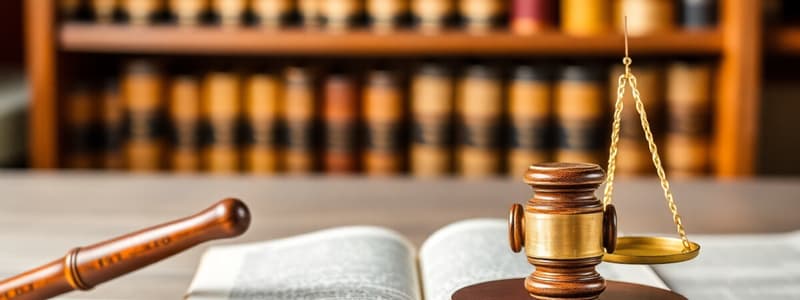Podcast
Questions and Answers
What is the primary purpose of Intellectual Property Rights?
What is the primary purpose of Intellectual Property Rights?
The primary purpose of Intellectual Property Rights is to encourage new creations, fostering technological and artistic advancements.
Name two examples of intellectual property.
Name two examples of intellectual property.
Two examples of intellectual property are inventions and computer programs.
How do Intellectual Property Rights benefit creators?
How do Intellectual Property Rights benefit creators?
Intellectual Property Rights provide exclusive rights that allow creators to reap commercial benefits from their inventions.
Why is it important for industry professionals to understand IPR?
Why is it important for industry professionals to understand IPR?
Signup and view all the answers
Where did the modern laws regarding Intellectual Property Rights originate?
Where did the modern laws regarding Intellectual Property Rights originate?
Signup and view all the answers
Study Notes
Intellectual Property Rights Introduction
- Intellectual property (IP) is the intangible product of the human mind, including ideas and representations.
- Intellectual property rights (IPR) are legal rights granted to inventors or creators to protect their inventions/creations for a specific time period.
- IPRs provide exclusive rights to creators to reap commercial benefits from their work.
- Understanding IPRs is crucial for creative businesspeople for domestic and international protection and marketing of products.
- Examples of intellectual property include inventions, publications, computer programs and music.
Genesis of IPR
- IPR legal procedures originated in Europe.
- In 1331, King Edward III of England granted a patent to a Flemish weaver, John Kemp, for his weaving technique.
- This allowed Kemp to control the production and teaching of his trade.
- Patents were initially used to raise funds for the Crown.
- However, this system led to conflicts between the Crown and Parliament, mainly over commodity control.
History of IPRs – Copyrights
- Italy's Venice is considered the cradle of the IP system, setting precedents in legal thinking.
- In 1873, an event called 'The World Exposition' was organized in Vienna, Austria to promote the exchange of education, knowledge, and culture, but American inventors boycotted it.
- During the 18th and 19th centuries, rights of inventors were mainly confined to their home country due to lack of modern technology.
History of IPRs – Paris Convention 1883
- Many inventors wished to participate in events, but feared their inventions being copied.
- This triggered a need for international protection of inventions.
- The Paris Convention in 1883 introduced comprehensive industrial property rights encompassing patents, trademarks, and designs.
- 11 countries initially joined the World Intellectual Property Organization (WIPO).
- Now, 193 countries have adopted this convention.
What About Uganda's IPR?
- Uganda's law protects intellectual property through the Uganda Registration Services Bureau (URSB).
- URSB conducts annual events to promote knowledge of IP rights and innovation.
- URSB handles the registration of intellectual property and enforcement through the judicial system, but enforcement is weak concerning piracy.
- Uganda signed the WIPO Patent Law Treaty in 2000.
Details About URSB
- URSB is an autonomous statutory body established in Uganda (Chapter 210, Laws of Uganda, 1998).
- The current board chairman is Ambassador Francis Butagira.
- The Registrar General is Mercy K. Kainobwisho.
- URSB is located at 1 Baskerville Avenue, Kampala.
ARIPO
- Uganda adopted ARIPO's (African Regional Intellectual Property Organization) draft protocol in 2021 for regional voluntary copyright registration.
- This ensured creators in member countries benefited from their works.
- Uganda still faces challenges in business investment due to political/democratic issues, economic mismanagement, and corruption.
What Will You Invent or Innovate?
- Students should research existing innovations, domestically and internationally.
- Use diagrams to present ideas and proposals for future inventions, keeping the work confidential.
Invention vs Innovation
- Inventions are original ideas, often resulting in significant change.
- Innovations are refined or improved ideas, creating practical applications.
- Inventions may not always be lucrative, and inventors may not see their work fully recognized.
- Innovations often involve collaboration, with wider distribution of knowledge and application.
Intellectual Property Rights That Automatically Arise
- This section lists various types of intellectual property rights that automatically arise, which include patent rights, design rights, chip rights, copyright, trademarks, plant breeders' rights, and database rights.
Studying That Suits You
Use AI to generate personalized quizzes and flashcards to suit your learning preferences.
Related Documents
Description
This quiz explores the fundamentals of Intellectual Property Rights (IPR), including their legal significances, historical origins, and examples. Understanding IPR is essential for creators and businesses to protect their innovations and reap commercial benefits. Test your knowledge on key concepts and historical milestones of IPR.



